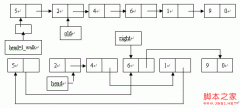数据结构:哈夫曼树的应用
#include
#include
#include
#include
#include
#define MAXVALUE 200 /*权值的最大值*/
#define MAXB99v 30 /*最大的编码位数*/
#define MAXNODE 30 /*初始的最大的结点数*/
strUCt haffnode
{char data;
int weight;
int flag;
int parent; /*双亲结点的下标*/
int leftchild; /*左孩子下标*/
int rightchild; /*右孩子下标*/
};
struct haffcode
{int bit[MAXNODE];
int start; /*编码的起始下标*/
char data;
int weight; /*字符权值*/
};
/*函数说明*/
/************************************************************************/
void pprintf(struct haffcode haffcode[],int n);
/*输出函数*/
void haffmantree(int weight[],int n,struct haffnode hafftree[],char data[]);
/*建立哈夫曼树*/
void haffmancode(struct haffnode hafftree[],int n,struct haffcode haffcode[]);
/*求哈夫曼编码*/
void test(struct haffcode haffcode[],int n);
/*测试函数*/
void end();
/*结束界面函数*/
/************************************************************************/
void haffmantree(int weight[],int n,struct haffnode hafftree[],char data[])
/*建立叶结点个数为n,权值数组为weight[]的哈夫曼树*/
{int i,j,m1,m2,x1,x2;
/*哈夫曼树hafftree[]初始化,n个叶结点共有2n-1个结点*/
for(i=0;i<2*n-1;i++)
{if(i hafftree[i].weight=weight[i]; /*叶结点*/ } else {hafftree[i].weight=0; /*非叶结点*/ hafftree[i].data='\0'; } hafftree[i].parent=0; /*初始化没有双亲结点*/ hafftree[i].flag=0; hafftree[i].leftchild=-1; hafftree[i].rightchild=-1; } for(i=0;i {m1=m2=MAXVALUE; x1=x2=0; for(j=0;j {if(hafftree[j].weight {m2=m1; x2=x1; m1=hafftree[j].weight; x1=j; } else if(hafftree[j].weight {m2=hafftree[j].weight; x2=j; } } hafftree[x1].parent=n+i; hafftree[x2].parent=n+i;
- 上一篇:通用子目录文件显示方法
- 下一篇:C++箴言:必须返回对象时别返回引用





